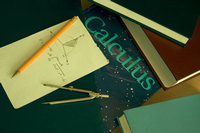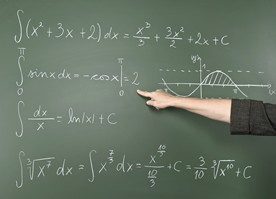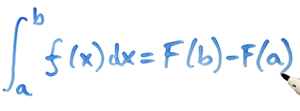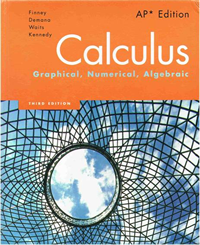AP Calculus AB: Course Syllabus
Course Code: MAC6120T
Welcome to the DoDEA Virtual High School. Thank you for visiting our course catalog. Please navigate through the syllabus below to find out more information about this DVHS online course. If you have questions, please contact us at your earliest convenience.
Course Description
 AP Calculus AB provides an understanding of the fundamental concepts and methods of differential and integral calculus with an emphasis on their application, and the use of multiple representations incorporating graphic, numeric, analytic, algebraic, and verbal and written responses. Topics of study include: functions, limits, derivatives, and the interpretation and application of integrals. An in-depth study of functions occurs in the course. Technology is an integral part of the course and includes the use of graphing calculators, computers, and data analysis software. On a regular basis, graphing calculators are used to explore, discover, and reinforce concepts of calculus.
AP Calculus AB provides an understanding of the fundamental concepts and methods of differential and integral calculus with an emphasis on their application, and the use of multiple representations incorporating graphic, numeric, analytic, algebraic, and verbal and written responses. Topics of study include: functions, limits, derivatives, and the interpretation and application of integrals. An in-depth study of functions occurs in the course. Technology is an integral part of the course and includes the use of graphing calculators, computers, and data analysis software. On a regular basis, graphing calculators are used to explore, discover, and reinforce concepts of calculus.
Though our system has an open enrollment policy, students should understand that this course is designed to be a fourth-year mathematics course and the equivalent of a year-long, college-level course in single variable calculus. The course requires a solid foundation of advanced topics in algebra, geometry, trigonometry, analytic geometry, and elementary functions. The breadth, pace, and depth of material covered exceeds the standard high school mathematics course, as does the college-level textbook, and time and effort required of students. AP Calculus AB provides the equivalent of the first course in a college calculus sequence, while AP Calculus BC is an extension of AP Calculus AB, and provides the equivalent of a second course in a college calculus sequence. Students are expected to take the AP Calculus AB Exam at the end of this course.
Image: A calculus textbook; iStock.com
Course Objectives
Upon completion of AP Calculus AB, students should be able to:
 Understand the major topics of functions, limits, derivatives, and integrals.
Understand the major topics of functions, limits, derivatives, and integrals. - Incorporate multiple representations of functions using graphic, numeric, analytic, algebraic, and verbal and written responses, and understand the connections among these representations.
- Construct an understanding of derivatives as an instantaneous rate of change, applications of derivatives as functions, and use various techniques to solve problems including local approximations.
- Understand definite integrals as a limit of Riemann sums, and as the net accumulation of sums, and use them to solve a variety of problems.
- Develop an understanding of the Fundamental Theorem of Calculus as a relationship between derivatives and definite integrals.
- Use graphing calculators to problem solve, experiment with ‘what if’ hypotheses, display and interpret results, and justify conclusions.
- Make sense of and determine the reasonableness of solutions including units of measurement.
- Develop an appreciation for an historical perspective of calculus.
DoDEA Math Standards may be viewed by clicking the link.
Image: A hand pointing to a math equation on a chalk board; ThinkStock.com
Course Outline
I. Functions, Graphs, and Limits
- Limits of functions (including one-sided limits)
 Asymptotic and unbounded behavior
Asymptotic and unbounded behavior- Continuity as a property of functions
II. Derivatives
- Concept of the derivative
- Derivative at a point
- Derivative as a function
- Second derivatives
- Applications of derivatives
- Computation of derivatives
III. Integrals
- Interpretations and properties of definite integrals
- Applications of integrals
- Fundamental Theorem of Calculus
- Techniques of antidifferentiation
- Applications of antidifferentiation
- Numerical approximations to definite integrals
AP Calculus AB Topic Outline: Click the link to view specific details of the course outline.
Image: Writing a mathematical equation on a whiteboard; Shutterstock.com
 Required Textbooks and Supplemental Readings
Required Textbooks and Supplemental Readings
Required Textbook
Finney, R. L., Demana, F.D., Waits, B.K., and Kennedy, D. (2003). Calculus: Graphical, numerical, algebraic, AP Edition. Upper Saddle River, NJ: Pearson Education-Prentice Hall.
Supplemental Textbooks and Readings
- Finney, R. L., Demana, F.D., Waits, B.K., and Kennedy, D. (2003). Technology resources manual for calculus: Graphical, numerical, algebraic. Upper Saddle River, NJ: Pearson Education-Prentice Hall.
- Hockett, Shirley O., Bock, David (2002). Barron’s How to Prepare for the AP Calculus AP Examination, 7th edition. Hauppauge, NY: Barron’s Educational Series, Inc.
Image: Calculus: Graphical, numerical, algebraic, AP Edition. Upper Saddle River, NJ: Pearson Education-Prentice Hall; Mrs. Brooks
Other Resources
 Computers: Each student has access to a computer with internet access at their local school during their scheduled class period. Most also have use of a computer at home. The entire course is conducted on-line. Most students also have access to a scanner or digital sender for submitting work, but a fax machine can be used if one is not available.
Computers: Each student has access to a computer with internet access at their local school during their scheduled class period. Most also have use of a computer at home. The entire course is conducted on-line. Most students also have access to a scanner or digital sender for submitting work, but a fax machine can be used if one is not available.
Software: Students use the Microsoft Office programs for projects and for accessing lectures. QuickTime Video is used to run Flash presentations and activities. Jabber is an instant messaging program that we use for real-time communications with the students. Windows Media is required for watching video presentations and demonstrations. Adobe Connect is used for whiteboard presentations with both video and audio real-time collaboration with students.
Graphing calculators are required by the College Board. Students may use any approved model; most use the TI-83+ or TI-89.
Internet access and online resources:
- Math Tools Website: http://www.mathforum.org/mathtools/cell.html?&new_co=c
- Math Archives: Calculus Resources On-Line Website: http://archives.math.utk.edu/calculus/crol
- AP Featured Question: http://apcentral.collegeboard.com/apc/members/courses/teachers_corner/23365.html
- Slope Fields handout: http://apcentral.collegeboard.com/apc/public/repository/slopefieldhandoutapnc_11870.pdf
- Featured videos from http://www.KhanAcademy.org
- Tutoring help from http://www.tutor.com is available free of charge to all of our students
- Online help from former students will be available at the FaceBook calculus page for the class

